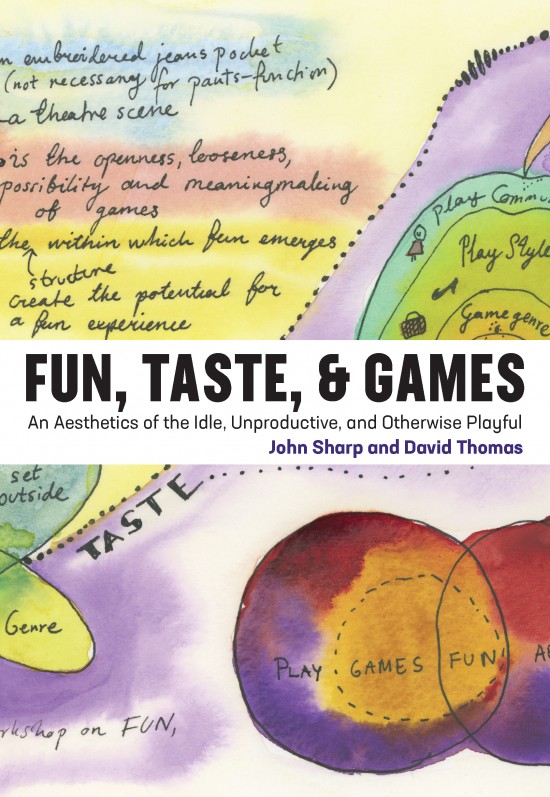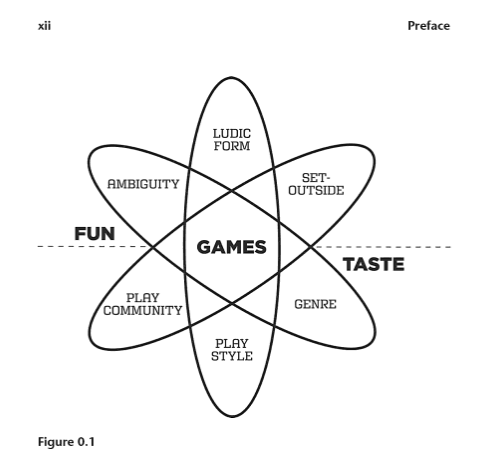What is a fun experience really about? I’ve gained new perspective from Fun, Taste, & Games: An Aesthetics of the Idle, Unproductive, and Otherwise Playful (MIT Press). I have first-hand knowledge that the authors, John Sharp (Parsons/New School) and David Thomas, are in fact, fun: They would probably join you at Casa Bonita*.
John and David talked about their book at The Enchantment Society in Denver. My initial response was: Fun in gaming? That’s just competing and improving your score/level or whatever – like someone who’s obsessed with making quarterly revenue targets. I now understand it’s more nuanced. The authors argue: “As beauty was to art, fun is to play and games ― the aesthetic goal that we measure our experiences and interpretations against.”

There’s plenty to ponder here, with a deep dive into history/studies of gaming plus Marshall McLuhan, Ada Lovelace and more. The aesthetic is viewed through the FTG (Fun, Taste, Games) lens, which transfers easily to other immersive experience forms (Sleep No More, Meow Wolf). And I believe it helps us understand the experience of deciding at work (sorry if I just sucked the fun out of this post).
Fun games can be analog, digital, or a combination, and the same goes for business decision-making environments. Of course game theory precedes the digital era (think prisoner’s dilemma). Researchers attempting to formalize game theory find that, with enough computing power, even games like Go are computable: Given play information in advance, an algorithm can predict the outcome. Some are not: New evidence suggests Magic the Gathering is the world’s most complex game and is not computable. Welcome to real-world decision-making.
How did decision-making and overcoming challenge become the dominant aesthetic?
Six elements contribute to the fun/games aesthetic: Ambiguity and Play Community. Genre, Set-Outsideness. Ludic Form and Play Style.


So how does this translate to business decisions? An aesthetic of deciding would depend on what we expect from a decision-making experience, and how we measure our interpretations. The challenge is to create “a carefully constructed opportunity built from a context (the ludic form), the individual’s attitude toward that context (set-outsideness), and the individual’s embrace of the structures and meaning to be made from the moment (ambiguity)”.
Six things to include in a decision-making experience.
Here’s my spin on applying the framework to an aesthetic for deciding. People can be nudged to apply evidence to decisions, which requires blending the experience they expect with appropriate guardrails. I hope others will build on this, point out my errors in logic (or tell me if it’s too much of a stretch).
1. Ludic form is the structure of the experience, a social form where decision-making emerges. Use (or misuse) of games to model real-life situations. The goal of ludic interface design is to offer ease of use. So for decision-making that would be… PowerPoint?
2. Set-outsideness describes an experience where we “set aside certain expectations of utility, efficiency, and expediency”. We cross a boundary into the artificial, pursuing purposeful activities without a greater outside purpose. Okay, this doesn’t sound like real-world decision-making, where pursuing a valuable purpose is… the purpose. However, the authors also describe activities that require us to be “set outside life so we can meta-analyze the conversation”. I think this can compare to discussions at the 30,000-foot view, or strategy games where executives consider analogs to better understand a complex problem.
An aesthetic of deciding would be shaped by expectations of the decision-making experience, and how we measure interpretations.
3. Play style: How people like the experience to unfold. Can the process be asynchronous? Does everyone need to prepare a formal presentation, or can things develop in real time? The style of the decision environment plays a big role in overcoming bias: McKinsey writes about the importance of managing meetings to allow multiple viewpoints, with senior leadership not offering opinions until last (to avoid sunflower management). Creative firms sometimes assign rotating roles, such as naysayer, champion, questioner, etc.
4. Genre: Choice of game. Does the group prefer to be far outside the daily grind, at an offiste, or across the hall in the nearest conference room? People’s roles in the decision process will strongly influence their expectations. Some will be better suited for data-intensive, day-to-day decision making fueled by BI dashboards. Others will prefer loosely formed exercises that spark new marketing concepts.
5. Play community: Who do you choose to decide with? This has to include not only decision-makers, but also 1) advocates and analysts who provide input, 2) groups who will be affected by the decision, and 3) people who will implement the decision.
5. Ambiguity: Provide structures that people can untangle to discover meaning.
Of course there’s plenty of advice on how to shape presentations to decision makers: Everything from candid, “here’s how things really are” conversations to slick, manipulative PowerPoint theater. But that’s not the same as creating a decision-making environment. I like the ‘aesthetic’ framework for developing the potential of people in various roles.
*I grew up in Tulsa, Oklahoma, a beautiful city with a noteworthy assortment of art deco architecure, plus Oral Roberts University and a Casa Bonita (since closed). Thanks to South Park, CB is now a Colorado thing.








